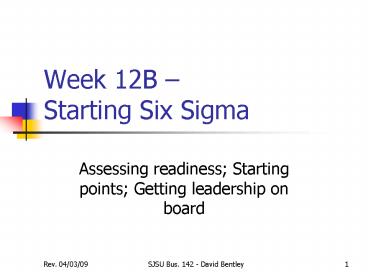Week 12B Starting Six Sigma - PowerPoint PPT Presentation
1 / 24
Title:
Week 12B Starting Six Sigma
Description:
Acquisitions, NPI, new systems, economic factors. 11/10/08. SJSU Bus. 142 - David Bentley ... If cross functional cooperation and integration are absent watch out! ... – PowerPoint PPT presentation
Number of Views:41
Avg rating:3.0/5.0
Title: Week 12B Starting Six Sigma
1
Week 12B Starting Six Sigma
- Assessing readiness Starting points Getting
leadership on board
2
Assessing Readiness
- Not all companies are candidates for six sigma
(and may never be)!
3
Looking into the future - Questions
- Do we have a clearly developed and stated
strategy for the future? - Whats the outlook for financial strength and
growth of the organization? - Is the organization agile and able to quickly
adapt to change?
4
Looking into the future Assessing the answers
- Answers of No to the three questions
- Not a good candidate at this time
- Need to strengthen organization first
- Answers of Yes to the three questions
- Good foundation exists for six sigma
- Mixed answers
- May need to focus on fixing the No
5
Looking at the present - Questions
- What are our current performance levels?
- Profit, return, growth, yield, k-sigma level,
dpmo, DPU, etc. - How well do we meet customer requirements?
- Satisfaction index, complaints, returns, warranty
claims, etc. - Whats our current efficiency level?
- Production efficiency, product cost, NPI time to
market, multi-functional synchronization, etc.
6
Looking at the present - Assessing the answers
- Positive answers to these questions
- May mean that six sigma is not urgent
- Negative answers to most or all questions
- May have a number of things to fix first
- Mixed answers
- Useful in setting priorities and establishing
focus for six sigma
7
Looking at fitness for change - Questions
- Whats the state of our systems for managing
change? - Performance measures, integration, etc.
- How well do we manage cross-functional processes?
- Multi-functional teams, cooperation, barriers
- What else is going on that might conflict?
- Acquisitions, NPI, new systems, economic factors
8
Looking at fitness for change - Assessing the
answers
- If systems are not in place this may be a good
place to start - If cross functional cooperation and integration
are absent watch out! - If other major activities are going on put six
sigma on the back burner.
9
When to say No to Six Sigma
- Six Sigma is not for everybody!
- Reasons why you might decline or hold off
- You are already doing very well (better than 95
of what can be achieved in quality - You have too much on your plate already put Six
Sigma in your long term plan - You recognize that the potential return is not
great enough to warrant the effort
10
Six Sigma Cost/Benefit Analysis
- Management is always going to ask 1) Whats the
cost?, and 2) Whats the return?
11
Potential Benefits
- Probably need to estimate
- Use averages, samples, expert opinion
- Find any concrete benefits you can
- Recognize and communicate the uncertainty of the
benefits data
12
The Time Element
- Results do not happen overnight
- Expect at least six to nine months before you see
any meaningful results - Time estimates are almost always too short
- Time affects the benefits and cost factors
13
Six Sigma Implementation Cost
- Labor (payroll)
- Full-time Six Sigma team members (Direct)
- Management, support staff, part-time team members
(Indirect) - Training and consulting
- Improvement implementation
- Equipment, major process changes, systems
- Other
- Occupancy, travel, etc.
14
Is a Cost/Benefit Ratio Right?
- Probably not!!
- Exceptions
- Specific, small projects
- Costs are much, much more than the benefits
- Other factors are probably more important
- Survival, competitiveness, customer satisfaction,
long-term savings - May require a Leap of Faith
15
Starting Points
- Objective, Scope, Timeframe
16
Objective 3 Possible Levels
- Business Transformation
- Major change in the business, such as greater
flexibility - Strategic Improvement
- High-level strategic areas, such as NPI
- Problem solving
- Drills down on specific areas or processes, such
as reducing days of accounts receivable
17
Scope - Organizational Factors
- Available resources
- Other concurrent activities
- Acceptance or resistance to change in various
areas
18
Timeframe
- Break down efforts with time estimates
- Find a meaningful and visible intended result
- Look for a reasonable quick win
19
Entries to the Roadmap
- Based on Objective Level
- Business transformation -gt Identify core
processes and key customers - Strategic improvement -gt Define customer
requirements - Problem solving -gt Prioritize, Aanalyze,
implement improvements
20
Pilots
- As always, it is preferable to start with a pilot
project, operation, organizational unit - Reduces risk
- More easily managed
- Easier to measure
- Can be tweaked
21
Leadership
- Identifying and preparing Six Sigma leaders
22
Identifying Leaders
- Organizational considerations
- Function
- Level
- Proven leadership results
- Active or potential interest in Six Sigma
- Visionaries
- Motivators
23
Leader Responsibilities - 1
- Articulation of case for Six Sigma
- Actively participate in
- Planning
- Implementation
- Create vision and plan for getting buy-in
- Be an unwavering advocate
24
Leader Responsibilities - 2
- Set clear, meaningful, attainable reasonable
objectives - Hold everyone accountable for meeting objectives
- Insist on valid measures of results
- Communicate results throughout the organization
frequently

